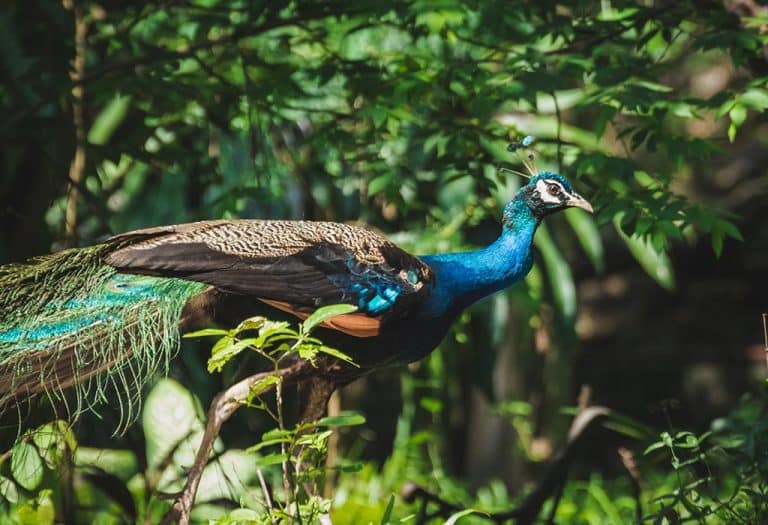Discovering the Wonders of African Animals
Do you want to know about the iconic African animals representing the continent’s amazing biodiversity? Africa is the second largest continent with a huge diversity of flora and fauna.
From insects to birds and mammals to reptiles, Africa is known for its impressive biodiversity and variety of habitats. It is also a popular safari destination visited by thousands of people worldwide to have a close encounter with the majestic animals.
You can see zebras and wildebeest migration, track gorillas through the rainforest, and watch lions stalk their prey at the national parks. Among the most popular African animals are the “Big Five” including the Buffalo, Elephant, Lion, Rhinoceros, and Leopard. Africa also houses endangered animals like the White Rhino, Black Rhino, Rothschild’s Giraffe, (African) Wild Dog, Grévy’s Zebra, Okapi, and Grey Crowned Crane.
Let’s take a look at the different animal species that you can encounter in Africa.
List of The Most Popular African Animals & Some Traits
| Animal Name | Scientific Name | Conservation Status | Places to see them |
| Aardvark | Orycteropus afer | Least concern | Aardvark Nature Reserve, Karoo Gariep Conservancy, Witsand Nature Reserve |
| Aardwolf | Proteles cristata | Least concern | Eastern Cape Oviston Nature Reserve, North West Northern Cape, Gauteng Rietvlei Nature Reserve |
| African Buffalo | Syncerus caffer | Least Concern | Katavi National Park, Chobe National Park, Lower Zambezi National Park |
| Bonobo | Pan paniscus | Endangered | Congo Basin of the Democratic Republic of the Congo |
| Boomslang | Dispholidus typus | Least concern | South Africa, Mozambique, Eswatini, Botswana, Namibia |
| Cheetah | Acinonyx jubatus | Vulnerable | Masai Mara GR, Kenya, Okavango, Kwando, Selinda, Lewa Downs, Kenya |
| Desert Locust | Schistocerca gregaria | Least concern | Kalahari Desert |
| Fennec Fox | Vulpes zerda | Least concern | Sahara Desert |
| Giraffe | Giraffa camelopardalis | Vulnerable | Samburu National Reserve, Kenya, The Giraffe Manor, Nairobi |
| Gorilla | Gorilla beringei | Critically Endangered | Democratic Republic of Congo, Congo Brazzaville, Uganda |
| Hippopotamus | Hippopotamus amphibius | Vulnerable | Kwazulu Natal’s iSimangaliso Wetland Park, Serengeti National Park, Tanzania |
| Hyena | Hyaenidae | Vulnerable | Serengeti/Maasai Mara (Kenya/Tanzania), Greater Kruger (South Africa) |
| Jackal | Canis aureus | Vulnerable | Masai Mara, Serengeti National Park, Kruger Park, Okavango Delta |
| Leopard | Panthera pardus | Vulnerable | The Greater Kruger, South Africa, South Luangwa National Park, Zamibia |
| Lion | Panthera leo | Vulnerable | Greater Kruger Area, South Africa, Serengeti-Mara Ecosystem, Okavango Delta, Botswana |
| Monkey | N/A | Least concern | Virunga National Park, DRC, Kruger National Park, South Africa, Bwindi Impenetrable National Park, Uganda |
| Okapi | Okapia johnstoni | Endangered | Forests of Central Africa |
| Black Rhinoceros | Diceros bicornis | Critically endangered | North Luangwa National Park, Zambia, Matobo National Park in Zimbabwe |
| Serval | Leptailurus serval | Least Concern | Kruger National Park, parts of Namibia, Botswana |
| Warthog | Phacochoerus africanus | Least Concern | Kruger National Park, Etosha National Park, Namibia, Chobe National Park |
| Mountain Zebra | subgenus Hippotigris | Vulnerable | Mountain Zebra National Park, |
Characteristics of The Most Famous African Animals
1. African Elephants

African Elephants are very intelligent and have excellent memory. They are the largest mammals in the world, and they prefer to live in herds of five to hundred animals. They are larger than Asian elephants and react aggressively if they feel endangered. African elephants communicate using their body language. In the wild, they make loud trumpeting sounds.
2. Fennec Fox

These small canine species are mostly found in the Sahara Desert. Their ears are very long and can even be half of their body size. They are omnivorous and feed on insects, rodents, fruits, and plants. They communicate with vocalizations, including whines, barks, yips, scent marking, and body language. They are nocturnal animals who rely on their group to defend their territory.
3. Lions

Lions are known to be the pride of the African wilderness. They are the second-largest members of the Felidae family. Lions are found in various habitats, including woodland, savanna, grassland, and the edges of deserts. They hunt at night as they have excellent night vision. Lions live in groups and can spend up to twenty hours resting.
4. Hippopotamus

Hippos are known to be the third largest land mammal, with females weighing up to 2,800 pounds and males weighing up to 3,000 pounds. An interesting fact about hippos is that in one feeding, they can eat 80 pounds of food. They are aggressive, and their behavior is unpredictable. Hippos are herbivorous and spend most of their time grazing on land. ,
5. Zebra
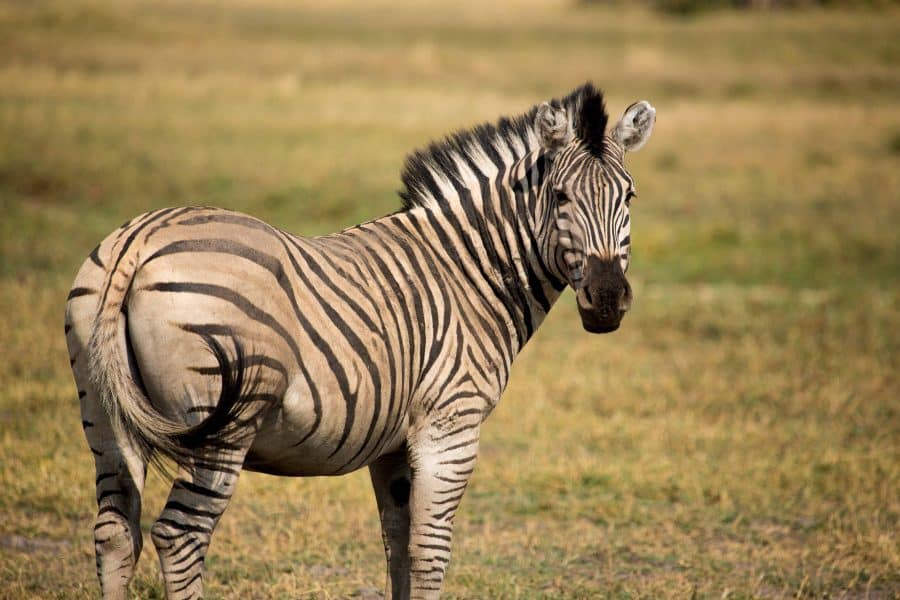
Zebras are native to southern and eastern Africa. Their diet is based on wild grasses, trees, and plants. They like to roam free and show stubborn behavior at times. Their behavior can differ depending on their breed. Some zebras are timid, while others are very aggressive. They exhibit loyalty towards their human handlers. When they feel unsafe or threatened, they bite and kick to defend themselves.
6. Spotted Hyena
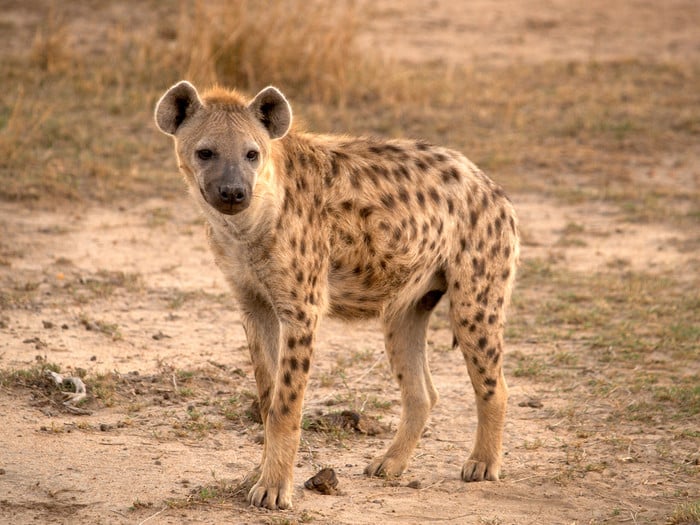
Spotted Hyenas are also known as laughing hyenas. They are scavengers and like to eat the leftovers of other predators. They can live up to 25 years and weigh around 50 to 86 kg. Spotted Hyenas are skilled hunters and can kill antelope and wildebeest easily. They mostly hunt at night and are found in pairs or alone. Their spotted pelt distinguishes them: whooping sound, pointed ears, and rounded snout.
7. Giraffe

Giraffes are known to be the tallest animal in the world. They are found in the woodlands and savannas of Africa. They can be easily recognized by their richly patterned coats, long necks, and ossicones on their heads. Each adult giraffe can weigh up to 1,700 pounds and need 75 pounds of plants daily to survive. They are herbivores and consume fruits, flowers, and leaves. They live in small groups of 10-20, and only the dominant male has access to the female members of the group.
8. Jackal

Jackals are nocturnal creatures that live alone, in pairs, or packs. They are omnivores and consume both animals and plants. They have pointed ears and slender, long legs. Depending upon their location and species, they vary in color. They have powerful jaws and can easily tear their prey’s flesh. They form strong bonds with their group members and help each other hunt.
9. Cape Buffalo

Cape Buffalo is one of the most commonly found animals in Uganda. They are known for their unpredictable temper, making it difficult to tame them. They are very dangerous and have earned a spot on the Big Five of Africa. Cape Buffaloes are herbivores and eat only shrubs and grass. They are so strong that they can even kill a lion.
10. Cheetah

Cheetahs have sharp eyes and tear-striped bodies. They are known to be the fastest animals on Earth. In just three seconds, they can reach more than 110 kilometers per hour. They measure around 40 to 60 inches in length from the hindquarters to the head and weigh between 75 and 125 pounds. Unlike other big cats, they hunt in late afternoon and early morning.
Some Endangered African Animals
1. Rhinoceroses
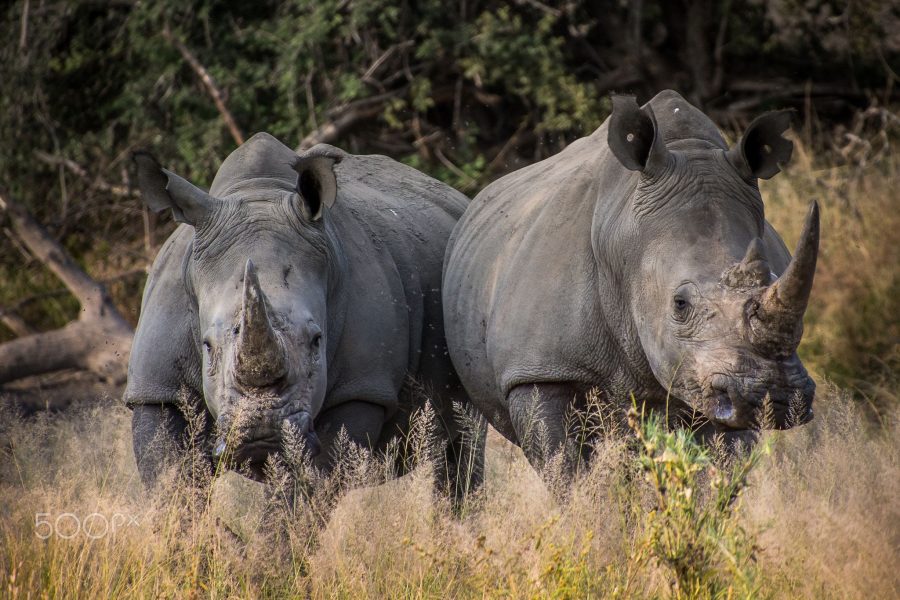
The Black and White Rhinoceros reside across southern and eastern Africa. Because of illegal poaching and hunting, only 27,000 wild rhinos remain, and they have been rendered an endangered species. They are solitary animals who only like interacting with their young ones or mothers. The unique thing about them is that they stick to the same territory lifelong and mark their territory with urine and feces to remember them.
2. Gorilla

Western and Eastern gorillas are critically endangered in Africa due to habitat loss from agricultural development and logging, poaching, diseases, and human conflict. The Cross River Gorillas are on the verge of extinction, with only 200-300 adults remaining in the wild. Their population recovery efforts are very slow because their reproductive rate is quite low. Most females only give birth every six to four years.
3. African Wild Dog
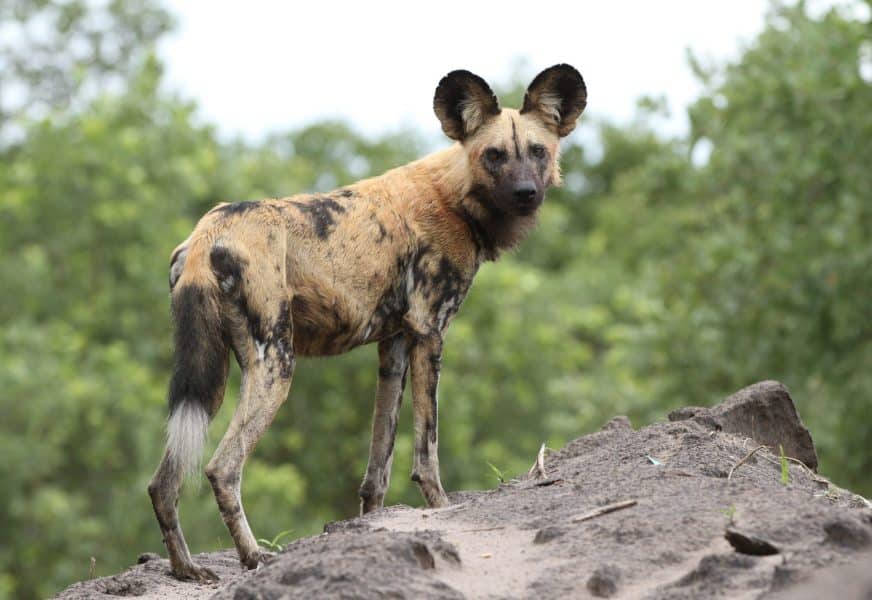
African wild dogs are the most endangered mammals in the world. In Africa, this critically endangered species has been listed as the second most endangered carnivore. Their largest populations are in East Africa’s southern part, including northern Mozambique and Tanzania. Their numbers have reduced significantly over the years due to wildlife trading and illegal poaching.
4. Saharan Cheetah

Saharan Cheetahs are on the verge of extinction in Africa due to habitat loss. They are hunted for their beautiful tan coat dotted by solid black spots. The remaining populations of Saharan Cheetahs can only be found in isolated pockets across the Sahel and Sahara from Mali in the west to Algeria and Niger and the Central African Republic in the east.
5. African Elephant
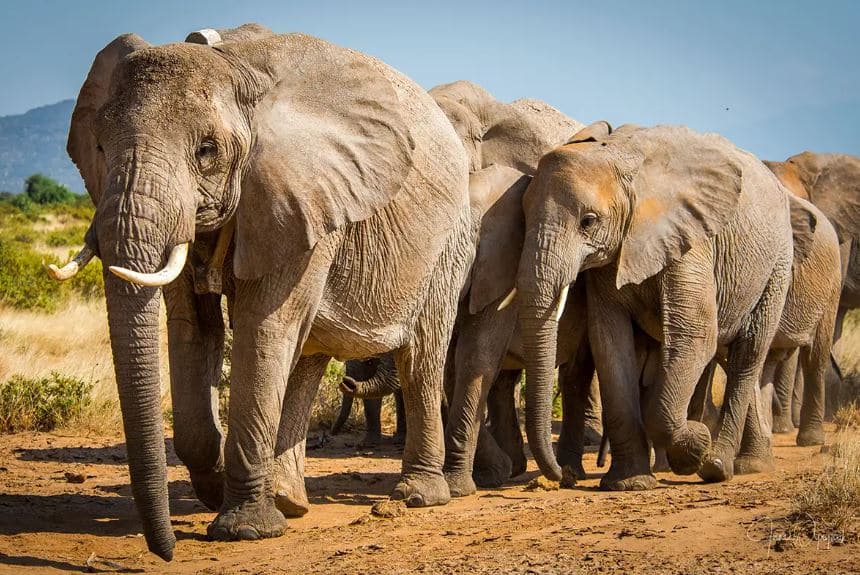
The population of African Elephants has declined rapidly in Africa. In the 1970s, there were around 1.3 million elephants in Africa, but their number has reduced to approximately 30,000 recently. Despite banning the international trade of their ivory, they are still heavily targeted and poached for their tusks made from meat, ivory, and skin. Their population is also getting reduced due to human-wildlife conflicts and habitat loss.
6. Rothschild’s Giraffe
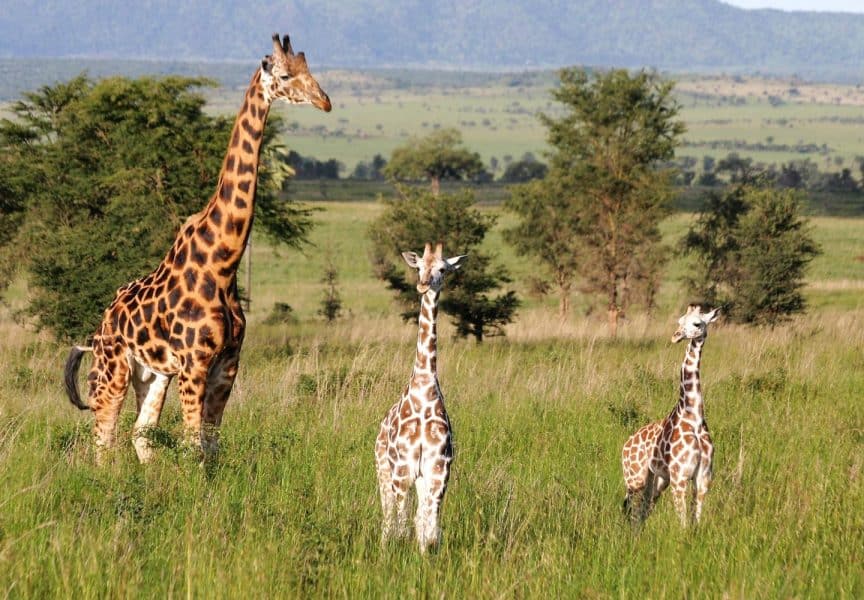
Rothschild’s Giraffes are 20 feet tall and have five ossicones on their head. Their isolated populations are mostly around the grasslands, savannahs, and open woodlands of Kenya’s and Uganda’s National Parks. They have been listed as endangered since 2010, and now only 670 Rothschild’s Giraffes exist in the wild.
7. Ethiopian Wolf

The Ethiopian Wolf is endemic to Ethiopia. Their population has reduced due to various factors, such as subsistence farming in the highlands of Ethiopia, rabies, and other diseases in the Bale Mountains. Foundations like the Oxford University Ethiopian Wolf Conservation Program carry out various community outreach programs to prevent the extinction of these animals.
Steps Taken to Save African Animals from Extinction
- Africa’s wildlife conservation approach combines wildlife translocations and reintroductions, habitat management, monitoring programs, and adequate research to undertake informed conservation actions.
- Through anti-poaching practices and stringent law enforcement, Africa’s wildlife conservation department is trying to provide safe areas for wildlife.
- SAFE African Vulture has collaborated with field partners in South Africa, Tanzania, and Kenya to address the threats to Africa’s vultures. Through conservation organizations, education toolkits, care, and educators, they’re continuing their vulture conservation engagement and education efforts.
- The African Wildlife Foundation has trained wildlife rangers and equipped them with anti-poaching equipment to prevent the killing of wildlife in protected areas. Located at major airports and seaports in Tanzania, Mozambique, Kenya, and Uganda, the handler and sniffer dog teams stop illegal wildlife products like rhino horn, ivory, and pangolin scales and the poachers and smugglers behind the killing.
Astonishing Facts About African Animals
- The Nile crocodile is one of the world’s largest reptiles known for its powerful bite. It can grow up to 6 meters in length.
- Pangolins are known to be the world’s most trafficked animals sold for their scales. They’re found in East, southern, and central Africa and are important in keeping the insect population in check.
- Giraffes give birth to their babies standing up. When the mother goes out, she leaves her newborn baby in the calving pool, known as giraffe daycare. An adult from the calving pool watches the calves until their mother returns.
- African lions are considered solitary animals, but in reality, they are very social. They live together in small groups known as prides. They are also skilled hunters and can kill prey larger than themselves, like zebras and wildebeests. While lionesses hunt, lions like to relax and unwind. They feed on the food brought by the lioness.
- Of all the Big Cats, Leopards are known to be the best climbers. They can jump 10 feet high and run 58 km/hr. They are not very fussy about food and like to eat anything from rodents and insects to porcupines and fish.
- African Elephants are very emotional, like humans. These mighty creatures mourn other elephants and share strong social bonds. They can even recognize themselves when they see in the mirror. African elephants use different objects for conducting complex tasks. For example, they bury the dead with the help of dead vegetation and use branches to swat flies.
- Hyenas form an integral part of Africa’s ecosystem. Their jaws are so strong that they can even eat bones. But only striped hyenas are scavengers. Around 95% of spotted hyenas hunt and then have their meal.
- Around 113 species of lemurs are found in Africa. The unique thing is that all of them are present on Africa’s Madagascar Island and other neighboring islands. Some lemurs stay active at night. The larger ones eat plants, while the smaller ones are omnivores. Out of all the lemur species, the ringtail lemur is the only one that doesn’t stay on the trees most of the time.
Conclusion
Africa is a haven for wildlife enthusiasts as you can find many wildlife species in abundance. With habitats ranging from desert to ice-capped mountains, savannas, and tropical rainforests, the continent houses many well-known animals, like the giraffe, hippopotamus, lion, African hunting dog, cheetah, African buffalo, and antelopes. You can also spot the Big 5 and endangered species in the wild. Human activities like deforestation and prolonged conflicts have led to a decline in the population of certain wildlife species on the continent.
You can check out the list of the endangered African animals mentioned above that are in dire need of conservation and protection.
Frequently Asked Questions
Are African Hunting Dogs on The Verge of Extinction?
Yes, African hunting dogs are the most vulnerable species on the continent. Throughout Africa, they are poisoned and shot by farmers who blame them when a hyena or leopard kills livestock. The African Wildlife Foundation has taken stringent steps to protect these carnivores. They encourage farmers to build enclosures to protect their livestock.
What are the Most Endangered Animals in Africa?
Many African animals have been identified as endangered species, and stringent steps are being taken to protect them. Some endangered African animals include the Northern White Rhino, Ethiopian Wolf, Riverine Rabbit, Black Rhino, Grevy’s Zebra, African Wild Dog, and Pickersgill’s Reed Frog.
How Can You Help in Wildlife Conservation?
There are many ways even common people can help in preserving African wildlife. Some ways include educating residents living near animal habitats by conducting community outreach programs. You can also practice reforestation and avoid using products that are made from animals that are on the verge of extinction.
What is the Most Unique African Animal?
Dugong is known to be the most unique African animal. However, okapis, pangolins, wildebeests, and ostriches are also considered odd creatures that are constantly looked for by tourists and locals.
What is the Rarest Animal to Spot in Africa?
Pangolins are known to be the rarest animals to spot in Africa. When you’re on a safari, it can be difficult to spot them as they are very shy and appear only after dark. Although they are present from Zambia to Kruger Park, not everyone can see them.




